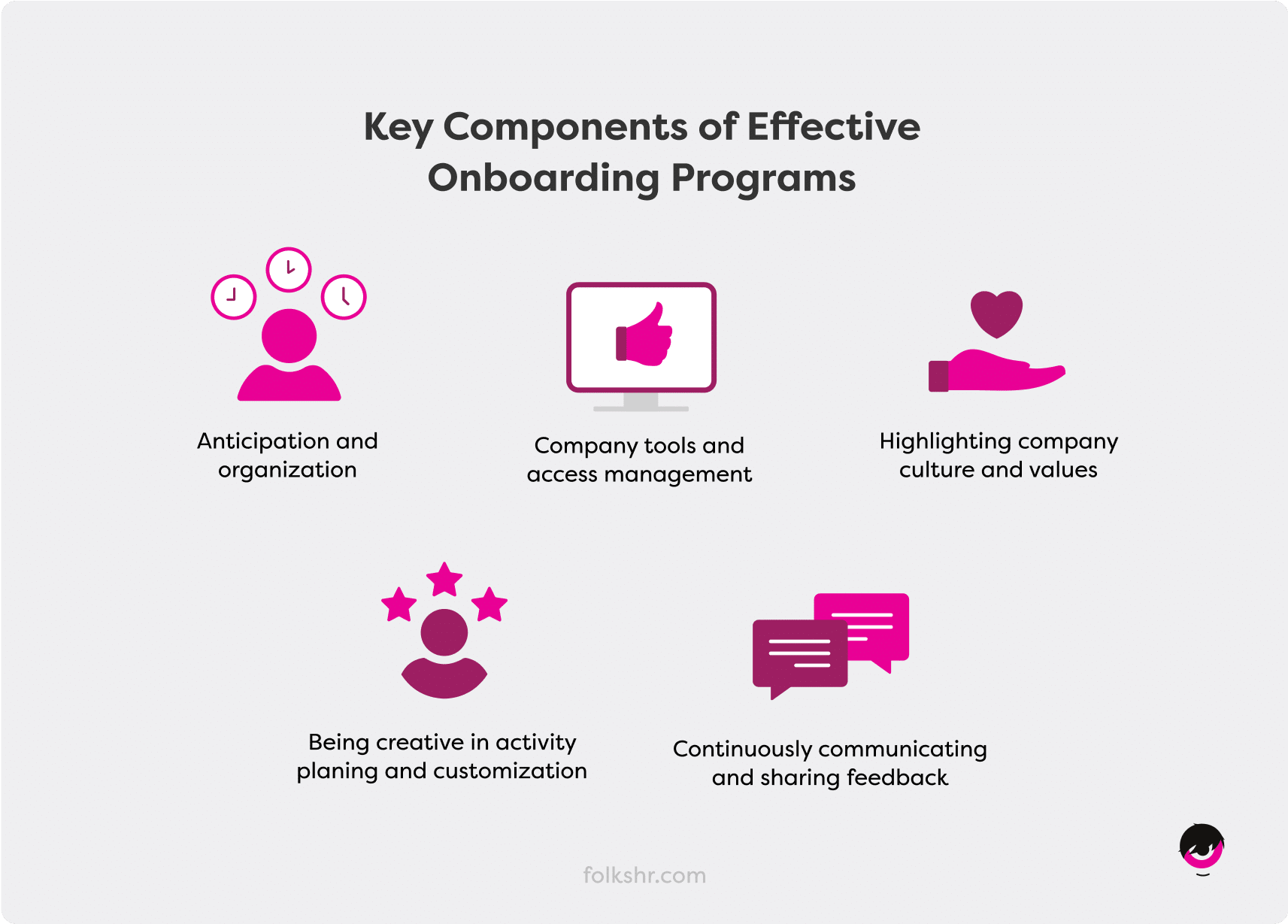Finding the right fit for your company is no small task. After the recruiting process is over, you still need to create a consistent onboarding experience to ensure hire retention. You need an effective employee onboarding plan if you want to motivate your new employees from the get-go!
Psst… Get to the end of the article to get an employee onboarding checklist!
How to Build your Onboarding Plan
It is time to build your onboarding plan, and you don’t know where to start? Here are the best employee onboarding practices you need to implement from the first days of employment:
- Clearly define key goals, how to achieve them and when, who is responsible;
- Prepare training material that supports performance expectations;
- Choose a supervisor to ensure an effective onboarding process;
- Customize and adapt your plan to the new hire’s job and expectations;
- Organize fun activities (that match your company values!);
- Prepare the end-of-probation performance review by sharing a schedule and role expectations with the employee.
You can also use Writecream’s example and define the three crucial steps of a formal onboarding program: Discovery, Engagement, Retention. This will give you a common thread to build the process from scratch!
Have you thought about automating your processes to optimize your processes? Folks’ onboarding features allow you to create different onboarding templates based on employees’ positions and directly assign tasks and deadlines. In addition, reminders are automated to save valuable time daily!
Essential Steps to Build Your Plan
1. Anticipation and Organization
The key to successful onboarding is preparation! Anticipate your new employee’s arrival and build your plan in advance so you are not caught off guard. This will require good organization skills and the use of appropriate tools.
The first step is to send a company-wide email so that everyone involved set aside time to welcome the new employee. As a result, your recruit will feel that their arrival is expected and appreciated!
Administrative tasks cannot be avoided, so prepare a list of onboarding documents you will need, such as direct deposit forms, contact details, and additional forms.
Another crucial step in your onboarding plan is automating reminders of onboarding tasks and deadlines. Unfortunately, email reminders are time-consuming and often do not fit your busy schedule. Instead, benefit from automated reminders by choosing an affordable HRIS: you will optimize your onboarding processes in no time, both in the office and remotely.
Other useful tools to have on hand are employee handbooks and onboarding checklists to avoid oversights. Check out our free employee onboarding checklist!
2. Company Tools and Communication Tools Management
Don’t wait until the last moment to set up your new recruit’s workstation. Prepare all the computer equipment and accesses they will need and useful goodies to celebrate their arrival. Pens and notebooks with the company’s logo are always a nice touch. Feel free to customize the new employee’s workstation to make it cozier. Why not encourage them to bring personal items to help them feel at home from their first day?
As for new remote employees, don’t forget to send them all the necessary tools and small welcome gifts in the mail. In any case, it’s essential that new employees get the comfort they need from the get-go.

3. Onboarding and Employer Brand
Take advantage of this critical time to promote your employer brand. It is important to build a solid reputation with potential candidates by making a good impression during your hire onboarding process. The onboarding journey is the perfect moment to:
- Share the company’s values;
- Highlight the benefits package, perks and opportunities you offer;
- Introduce the different teams and schedule meetings between employees;
- Answer all questions and make yourself available;
- Promote team spirit and healthy professional relationships.
Remember that the onboarding journey is a crucial engagement opportunity for all organizations.
4. Onboarding Activity Ideas
- Introduction videos and questionnaires
Why not create videos presenting the company and its teams? These videos will undoubtedly appeal to your hires, who will be able to discover company colors and company goals. That’s what we do at Folks, and everyone loves it!
Of course, it’s essential to involve your staff in the onboarding video so that the new employee gets to know their team. Similarly, you can create questionnaires about your new hire’s hobbies and quirks and share the answers during an introductory meetings.
- Welcome box with small gifts
A welcome box filled with gifts is always a plus to make you stand out. Clothes with company colors are also a great way to create a close relationship from the very first days. In short, start your professional relationship with signs of recognition.
- Team lunch
Team lunches are a timeless classic that help highlight team culture, on top of offering a welcome break to everyone. Use this event to build authentic connections! Team culture should be promoted throughout the entire process.
5. Communication and Continuous Feedback
Onboarding is not just a one-day event. It is a long process that must be supported by good communication and constructive feedback.
Don’t hesitate to ask them what they liked – or didn’t like – during their first few days with you. This continuous feedback will help you build an effective onboarding process.
It is also important to find a balance between autonomy and monitoring: the employee should not feel overwhelmed or left to their own devices. Therefore, you should schedule meetings on a regular basis and use the appropriate communication tools to stay connected, especially when managing remote employees.
By quickly identifying motivation or comprehension issues, you can act before these problems impact the entire company.
You need to use KPIs (Key Performance Indicators) to build an efficient HR strategy! Folks HR offers detailed HR reports that will quickly become essential to your management.

Examples of Effective Onboarding Programs
Here are helpful examples of onboarding plans to help you start your own. First, check out this welcome kit created by Specify! It outlines corporate values, steps to take during the first few days, and what the new employee can expect.
Here are Sendible’s great tips for building your onboarding plan:
- Build a solid 30/60/90 day onboarding plan. Each 30 days has an objective (from learning to building to ownership) and your goal is to come up with a list of actionable things you’d like your new hire to do. From taking free courses and receiving training to getting them to contribute on their first major project. Think backwards for this, i.e., where do you want them to be in 90 days and go from there. For example, if you want your new hire to manage your educational blog (or any other marketing channel), start their onboarding by assigning blog updates, then moving on to writing new content, then doing a content/SEO audit, and then slowly starting to manage the blog schedule.
- Let your employees plan in a way that makes sense to them. Give your new hires the onboarding checklist and let them plan it all out on the project management tool that your team uses. Introduce them to the methodology you use, but also give them their own private space to plan things their way.
- Encourage them to share feedback, ask questions, and most importantly, raise issues as they see them! Give agency to new hires to come in, question processes, and suggest how to improve them where needed. Sure, a corporate company will benefit much less from this approach as every process follows a strict checklist, but for everyone else, the eagle eyes of a newcomer can help unearth some key areas that need improvement right away.
You can use these examples and tips to build a successful onboarding program for optimized hire experience.

An effective employee onboarding process has many benefits: increased hire retention rates, promotion of your corporate culture and its core values, more productive employees and improved social connections…
In short, employee onboarding programs will set the tone for your entire collaboration. Your ultimate goal is to maintain good management practices throughout your entire company. This way, employee satisfaction will increase and support your company mission!
Need to optimize your entire onboarding program?
Here is an onboarding plan template you can follow to improve onboarding experience!

